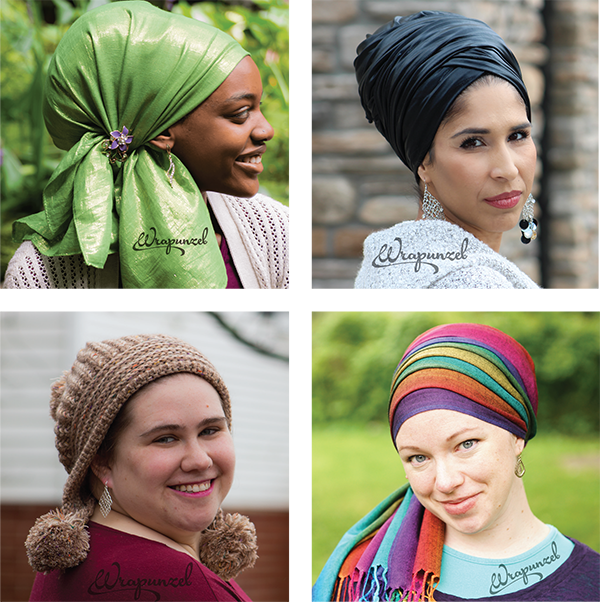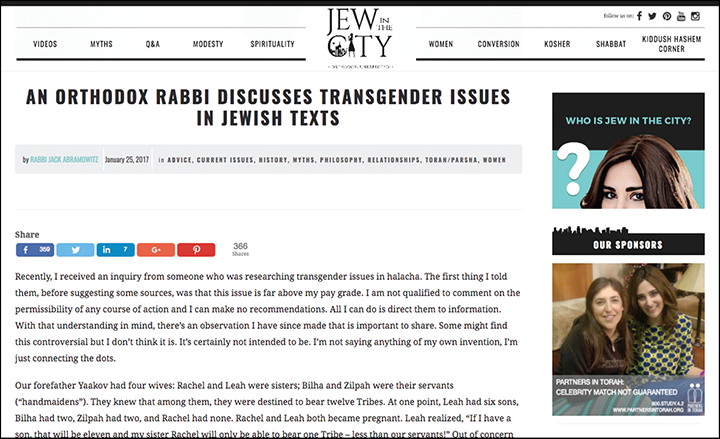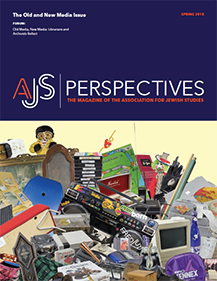
New media, however, can also just as easily critique moral failures as create them. Berlin-based Israeli writer Shahak Shapira, for example, uses Photoshop to satirize “thoughtless” selfies taken at Holocaust sites. Shapira contrasts the original selfies with photoshopped versions posing the “social-media obsessed youngsters” in archival images of death camps. Like Shapira, Jewish women have found that new media can provide a creative, ethical space. I am particularly interested by how ultra-Orthodox Jewish women use new media, in large part because most previous discussions have focused on how Haredi men use digital tools to efface women. Through new media, women refashion self and communities.
When blogging, ultra-Orthodox women create identities for themselves and share those identities with others. As Brian Alleyne notes in Narrative Networks: Storied Approaches in a Digital Age, the social part of new media is crucial. Like social media, blogs allow us to “bridge the gap among our personal sense of self, our desire to be seen in certain ways by others, and our sense of how others see us.” The “others” who see ultra-Orthodox women varies: while some blogs are aimed at ultra-Orthodox women themselves (kollelbudget.com), others are designed either explicitly for outreach (jwrp.org), or merely promote an Orthodox Jewish women’s lifestyle as a fulfilling choice (joyofkosher.com).
While ultra-Orthodox publications often erase women’s bodies, vlogs (video blogs) emphasize women’s physical presence. Blogs can use avatars to circumvent taboos surrounding seeing women, but vlogs typically rely on an actual person’s presence. As Amy Schmittauer notes in Vlog Like a Boss: How to Kill It Online with Video Blogging, ideally vloggers should look “into the eyes of your viewers when you talk to the camera” because eye contact emphasizes that “You understand them. You help them. You relate to them. That is all vlogging is. It’s being human on camera.” Orthodox women seem to agree. Lori Palatnik, the founding director of the Jewish Women’s Renaissance Project, uses videos on her YouTube channel Lori Almost Live to inspire Jewish women “with the beauty and wisdom of their heritage.” Yet her videos also showcase her role as a public speaker, a job that relies on body language. Jewish Women International named Palatnik one of the ten “Women to Watch,” an honor implying Palatnik can actually be seen, unlike the women photoshopped from print media.
Vlogs underscore that women can be virtuous in both domestic and public spaces. This dual role runs counter to Rabbi Pesach Falk’s popular tome on zni‘ut (modesty), whose ideology seems to prohibit “a woman from standing out—and from being outstanding.” These prohibitions go beyond dress: even women’s attendance of parents’ night at school has been denounced as “immodest” in some Haredi publications, as Shapiro notes. Vlogs allow Haredi women to redefine acceptable female roles. In Out of the Orthodox Box, Ruchi Koval explains she is a wife and mother, but also a Sunday school director, “a certified parenting coach, motivational speaker, musician, and author.” Indeed, Koval’s podcasts and YouTube channel play a role in her social mobility, as they promote book sales and paid speaking engagements.
Ultra-Orthodox women use vlogs in outreach, but also to provide tips on sheitl care, head-scarf wrapping, and cooking—all professions highlighting their status as women of valor. Vlogs like Wrapunzel do more than “inspire happiness with the art of hair wrapping”: they also suggest ways for women to navigate the professional world while maintaining an Orthodox lifestyle. These same vlogs rejuvenate Jewish practice. Wrapunzel’s Andrea Grinberg incorporates new styles and ethnic fabrics into Jewish practice. Wrapunzel’s companion store offers an innovative way to make money while simultaneously striving to increase women’s positive self-image. Grinberg’s physically and ethnically diverse models challenge Orthodox communities’ focus on whiteness and thinness as an ideal (fig. 2).

By foregrounding Orthodox women as authorities, blogs potentially destabilize male prerogative. On the one hand, when Allison Josephs, the founder, director, and main spokeswoman of the Orthodox women’s blog Jew in the City, has a tricky question, she turns to Jew in the City’s male educational correspondent, Rabbi Jack Abramowitz. Her approach models how Orthodox women are typically encouraged to get answers about Jewish law. Rabbi Abramowitz not only edits OU Torah but also has authored six books, including a book on zni‘ut. Moreover, Rabbi Abramowitz explicitly reinforces rabbinical authority in his post on “transgender issues.” He cautions “gender issues in halacha are already far more intricate than many would assume” and suggests we “leave the halachic issues for those at that pay grade. All you and I can do—all we should do—is just be a mentsch.”
Yet the blog’s structure subtly undercuts rabbinically trained men as the main religious authority on women’s issues. Visitors to the Jew in the City come primarily to hear an Orthodox woman’s perspective, not a rabbi’s. Moreover, the blog’s layout emphasizes the primacy of women’s voices. The byline for Rabbi Abramowitz in his article “An Orthodox Rabbi Discusses Transgender Issues in Jewish Texts,” is small, particularly compared to the large photos of Allison Josephs. In the blog’s context, female authority licenses Abramowitz to speak: if we listen to him, it is because Allison Josephs suggests we should (fig. 3).

Jewish Texts” (Jew in the City, 2017). Courtesy of JewInTheCity.com.
Blogs rely on a different formula for gaining their readers’ trust. Unlike Haredi editors, Google is more interested in a page’s number of links and “ranking signals” than what yeshiva the author attended or rabbinical letters of approbation. The Internet democratizes publication. Google searches place Jew in the City’s discussion of “transgender issues” alongside SOJOURN’s post highlighting halakhic opinions respectful of people post-transition. Equally important, the same search might also return The Second Transition, in which Abby Stein presents her own experience of being transgender in an ultra-Orthodox community (fig. 4). As a woman ordained by a Hasidic yeshiva, Stein reminds us that traditional credentials don’t always come in male forms. Like a postmodern Talmud, Internet searches provide a ring of conflicting voices circling any idea in Jewish life. Yet unlike the Talmud, the nature of the voices has changed.

New media allows women to refashion their identities for themselves and others. As Avital Chizhik-Goldschmidt noted in a recent Forward article, men’s “terrible discomfort with women stepping into the public light” via social media underlies why they “slut-shame” ultra- Orthodox women for wearing “immodest” sheitls. For Chizhik-Goldschmidt, the Internet provides “an uncensored, unmoored territory,” a place where women can “express themselves in totality—their spiritual selves, their silly selves, their vain selves.” Self-fashioning and self-presentation is not just for narcissists. New media allow ultra-Orthodox women to publicize themselves as outstanding—and even ordinary—women.

